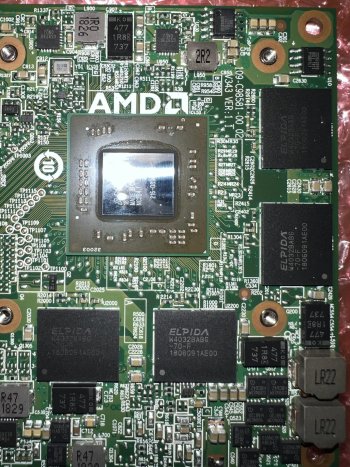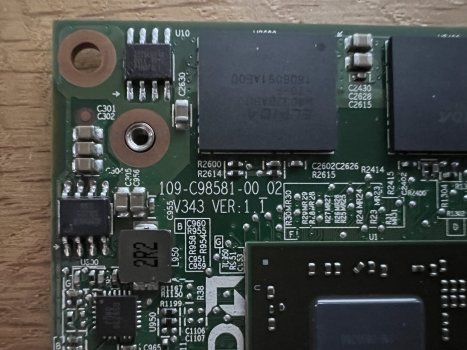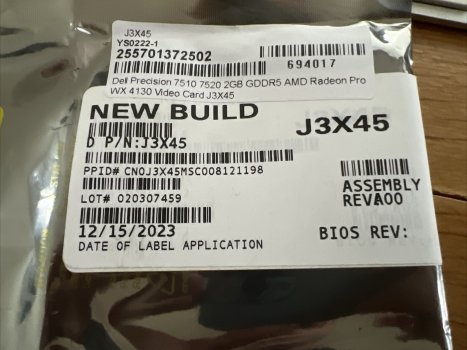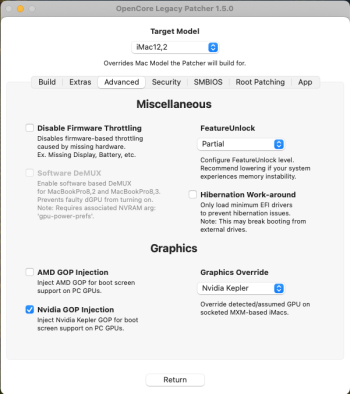Q: Which graphics card will work at all?
Only cards fitting into the
MXM3 slot can be installed in the iMacs models listed below. Older iMacs have an MXM2 type slot which is incompatible with newer MXMX3 cards.
Q: Which MXM3 card will physically fit into my iMac?
There are
smaller MXM-A cards which can be physically installed in all systems listed below. No heat sink mod needed! (see picture attached to post).
There are
bigger MXM-B cards running stablely
only in the 27" models. These cards can be installed into a 21.5" or 24" model MXM3 slot, but will be unstable due to their high
power draw, will not fit onto the smaller heat sink, will over heat the iMac after a short while or simply not boot. Do not try it and do not ask for support!
Nearly all those MXM-B cards
need the big three copper pipe MXM-B
heat sink from the 27" mid 2011 model with the 6970M card to get the generated heat out of the system under load - and all NVIDIA need a heat sink mod with a Dremel (see picture attached to post). A few AMD cards need a different Dremel mod. Check the GPU tables for details.
Q: Is there is a single optimal card?
No! Your iMac model, your budget, your comfort level with doing modifications, your ability to live with unresolved issues, your computing needs, the local market, etc. will determine the card to be used.
Q: Where do I get a card?
Unfortunately, this thread cannot help you source cards as there are too many variables involved. Do not post online offers, these are out of date the moment you publish it.
Q: Is there a most feature rich card?
There is a feature rich card - the AMD WX4130. But it will work only in eDP (see table below) iMacs without modification using the EFI or GOP vBIOS. Like other GCN4 cards this model offers DRM, 4K HEVC, 4K H.265, VideoToolbox, and native macOS Monterey support. Still usable with patches on Ventura and Sonoma, but YMMV.
Q: What are the most future proof cards?
AMD GCN4 and AMD RX 5500 XT cards - the latter lacks Ventura and Sonoma support.
Q: Is there a card which will fit in all iMac models?
There is a most compatible card, the M4000/M5100/W5170M. It can run in any iMac listed below offering an EFI boot screen with the correct vBIOS flashed. Keep in mind: eDP and LVDS type iMacs need different vBIOS versions.
Q: Are there incompatible combinations of cards an iMacs?
Yes, there are! But there is a most compatible receiver, the iMac11,3 27, which can run literally every card tested, listed, or mentioned on the thread (iMac11,1 is compatibly in the same way). For all other iMacs you have to read and work through this entire page.
Read through this information carefully in order to choose the best card for your needs.
Q: Which iMac models can be upgraded?
System support table:
| card/system family | iMac9,1 24 | iMac10,1 21.5 | iMac10,1 27 | iMac11,1 | iMac11,2 | iMac11,3 | iMac12,1 | iMac12,2 |
| connector type | LVDS | LVDS | eDP | eDP | eDP | eDP | eDP | eDP |
| NVIDIA (EFI) | no | no | no | yes | yes | yes | yes | yes |
| AMD (GOP) | yes | yes | yes | yes | yes | yes | yes | yes |
| AMD EG2 (EFI) | no | no | no | yes | yes | yes | yes | yes |
| AMD EG (EFI) | yes | yes | yes | yes | yes | yes | yes | yes |
- NVIDIA (EFI): EFI boot screen support, press alt/option on boot, Windows EFI/UEFI support, only eDP
- GOP: OpenCore for emulated boot picker (press ESC on boot, not alt/option), Windows UEFI support
- AMD EG2: EFI Boot screen support with iMac EG2 firmware modification, limited Windows UEFI support
- AMD EG: EFI Boot screen using the EnableGop driver enhancing GOP, Windows EFI/UEFI support
Q: What does GOP and EFI mean at all?
GOP is an UEFI2.0 driver found in any properly flashed post 2012 graphics cards. Our iMacs uses EFI 1.1 drivers to provide the well known Apple EFI boot screen. The GOP driver - on the other hand - will provide an emulated boot picker (press ESC on boot,
not alt/option) when using OpenCore boot loader and it provides Windows 10/11 UEFI driver support.
Since Apple owners are used to the EFI boot picker we developed drivers to support the EFI picker. All NVIDIA vBIOS have an EFI driver included, for AMD we have two different developments named EG2 and EG. We recommend using the EG version.
Q: What is the difference between AMD and NVIDIA cards?
AMD cards have better macOS support, in particular on Monterey and later and there is at least a single model for every MXM3 iMacs available. AMD GCN1-3 need 10.10, AMD GCN4 need 10.12 and Navi cards need 10.15 minimum to get macOS driver support.
NVIDIA cards lost support with Monterey. Patching started there an became with Ventura and Sonoma more and more difficult, expect to only limited support with Ventura and later macOS versions. Do not fall for old over priced 8GB cards just to run Big Sur. But you can run older macOS versions back to 10.8.3 using a NVIDIA card. You cannot use NVIDIA properly in LVDS iMacs (no EFI boot screen support).
Q: What is about other MXM3 cards?
Post High Sierra macOS support is limited to NVIDA Kepler GPU and AMD GPU from 2012+ (GCN1-4, RDNA), therefore we do not discuss the use of Maxwell or Pascal cards here, although these run perfectly with High Sierra, Windows, and Linux. Check this
thread to get more information.
Q: What does patching with OCLP mean in detail?
When Apple publishes a new macOS and drops support for older hardware usually drivers for older hardware will be removed from new macOS versions. To maintain support the OCLP team has to identify those drivers and re-insert them into the recent macOS. This sounds like playing with Lego (software) pieces, unfortunately it is much more complex. Starting with Monterey for Kepler and with Ventura for AMD this patching process could not completely recover full functionality. Patching is now altering the root volume installation provided by Apple. It needs lowering SIP (disable it partially, which cannot be enabled, again). One result is the loss of delta OTA updates. Whenever the update process starts Apple will notice the altered root volume and load a full installer to recover the complete installation. Finally Apple changed compiler flags for macOS and now it needs a CPU capable of running AVX2 instructions - another obstacle since no iMac CPU from the list above supports AVX2.
If this information is not really clear ask about support and experiences with older iMacs or search this thread.






